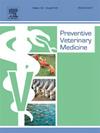A Bayesian latent class estimation of the diagnostic accuracy of clinical examination and laboratory assays to identify bovine ephemeral fever virus infection in South African cattle
IF 2.2
2区 农林科学
Q1 VETERINARY SCIENCES
引用次数: 0
Abstract
Bovine ephemeral fever (BEF) is an economically important vector-borne viral disease of cattle and water buffalo in Africa, Australia and parts of Asia. The control of BEF is centred around vaccination, and therefore accurate, early identification of disease outbreaks are key to minimize its economic and welfare impact. In Africa, control programs are hampered by limited diagnostic capabilities and poor infrastructure for rapid transportation of diagnostic specimens. The primary objective of this study was to estimate the sensitivity (Se) and specificity (Sp) of four tests, namely clinical examination by a veterinarian, virus isolation and two different conventional PCR assays, to identify an acute bovine ephemeral fever virus (BEFV) infection in diseased, naturally infected South African cattle, without the assumption of a reference standard. Samples and data were collected from cattle with clinical signs suggestive of BEF rather than a random sample of cattle. A case was categorised as clinical examination positive if the examining veterinarian considered acute BEFV-infection as the most likely aetiology. Virus isolation was performed using the buffy coat of heparin blood samples on baby hamster kidney cell cultures, evaluating cytopathic effect and confirming virus morphology by transmission electron microscopy. PCR was performed using two previously published protocols: The Ephemerovirus L-gene PCR (targeting the RNA-dependent RNA polymerase gene) and a BEFV G-gene PCR (targeting the neutralising G1 epitope of the glycoprotein). A single population, four test Bayesian latent class model with conditional dependence between the two PCR assays was implemented. The prevalence of BEFV-infection was high in this study population of clinical suspects at 67 %, (95 % Probability Interval (PI) 52 %; 81 %). Clinical examination provided a reasonable indication of acute BEFV infection (Se of 86 % (PI 77 %; 93 %) and Sp of 67 % (PI 52 %; 82 %)). Virus isolation was the most specific (99 % (PI 97 %; 100 %)), but least sensitive assay (30 % (PI 20 %; 44 %)). Of the two conventional PCRs, the L-gene PCR outperformed the G-gene PCR: The L-gene Se was 64 % (PI 51 %; 76 %) and Sp 96 % (PI 84 %; 100 %) compared to Se of 50 % (PI 38 %; 61 %) and Sp of 89 % (PI 75 %; 98 %) for the G-gene. While the laboratory assays presented excellent positive predictive values within this high disease prevalence population, the poor negative predictive values limit their usefulness to field veterinarians attempting to exclude BEF as diagnosis. Novel pen-side diagnostics should be developed due to the limitations of currently available assays and infrastructure constraints prevalent in Africa.
鉴定南非牛短暂热病毒感染的临床检查和实验室分析诊断准确性的贝叶斯潜类估计
牛短暂热(BEF)是非洲、澳大利亚和亚洲部分地区牛和水牛的一种重要的经济媒介传播病毒性疾病。对BEF的控制以疫苗接种为中心,因此,准确、早期识别疾病暴发是尽量减少其经济和福利影响的关键。在非洲,由于诊断能力有限和诊断标本快速运输基础设施薄弱,控制规划受到阻碍。本研究的主要目的是在不假设参考标准的情况下,估计四种检测方法的敏感性(Se)和特异性(Sp),即兽医的临床检查、病毒分离和两种不同的常规PCR检测,以在自然感染的患病南非牛中识别急性牛短暂热病毒(BEFV)感染。样本和数据是从有提示BEF临床症状的牛中收集的,而不是随机抽取牛样本。如果检查兽医认为急性befv感染是最可能的病因,则将病例归类为临床检查阳性。用肝素血液样品的灰白色外壳对幼鼠肾细胞培养物进行病毒分离,通过透射电镜评估细胞病变效果并确认病毒形态。采用先前发表的两种方法进行PCR:蜉蝣病毒l基因PCR(靶向RNA依赖性RNA聚合酶基因)和BEFV g基因PCR(靶向糖蛋白的中和性G1表位)。采用单种群、四检验贝叶斯潜类模型,两种PCR检测之间存在条件依赖关系。本研究临床疑似人群中befv感染率较高,为67 %,(95 %)概率区间(PI) 52 %;81 %)。临床检查提供了合理的急性BEFV感染指征(Se为86 % (PI为77 %;93 %),Sp 67 % (PI 52 %;82 %))。病毒分离特异性最高(99 % (PI 97 %;100 %)),但最不敏感的试验(30 % (PI 20 %;44 %))。在两种常规PCR中,l -基因PCR优于g -基因PCR: l -基因Se为64 % (PI为51 %;76 %),Sp 96 % (PI 84 %;100 %),而Se为50 % (PI为38 %;61 %),Sp 89 % (PI 75 %;98 %)。虽然实验室检测在这一疾病高发人群中呈现出极好的阳性预测值,但较差的阴性预测值限制了其对试图排除BEF作为诊断的现场兽医的有用性。由于目前可用的检测方法的局限性和非洲普遍存在的基础设施限制,应该开发新的笔侧诊断方法。
本文章由计算机程序翻译,如有差异,请以英文原文为准。
求助全文
约1分钟内获得全文
求助全文
来源期刊

Preventive veterinary medicine
农林科学-兽医学
CiteScore
5.60
自引率
7.70%
发文量
184
审稿时长
3 months
期刊介绍:
Preventive Veterinary Medicine is one of the leading international resources for scientific reports on animal health programs and preventive veterinary medicine. The journal follows the guidelines for standardizing and strengthening the reporting of biomedical research which are available from the CONSORT, MOOSE, PRISMA, REFLECT, STARD, and STROBE statements. The journal focuses on:
Epidemiology of health events relevant to domestic and wild animals;
Economic impacts of epidemic and endemic animal and zoonotic diseases;
Latest methods and approaches in veterinary epidemiology;
Disease and infection control or eradication measures;
The "One Health" concept and the relationships between veterinary medicine, human health, animal-production systems, and the environment;
Development of new techniques in surveillance systems and diagnosis;
Evaluation and control of diseases in animal populations.
 求助内容:
求助内容: 应助结果提醒方式:
应助结果提醒方式:


